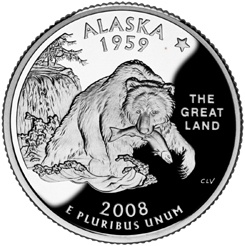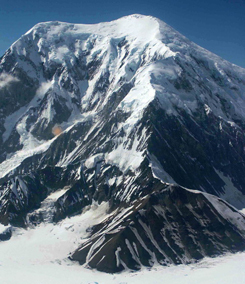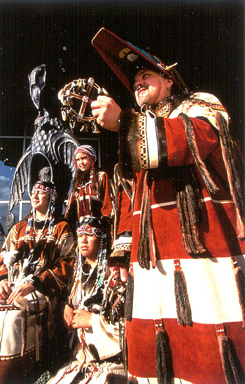
- Capital City:
- Juneau
- Nickname:
- Last Frontier, Great Land, Land of the Midnight Sun
- Motto:
- North To The Future
- Statehood:
- January 3, 1959 (49th)
- Origin of State's Name:
- Russian version of Aleutian word "Alakshak" meaning "great lands" or "peninsula."
- Largest Cities:
- Anchorage, Fairbanks, Juneau, Sitka, Soldotna
- Border States:
- None
- Land Area:
- 570,374 sq. mi., Largest state
- State Bird:
- Willow Ptarmigan
- State Flower:
- Forget Me Not (myosotis alpestris)
- State Tree:
- Sitka spruce (picea sitchensis)
- State Song:
- Alaska's Flag
One nickname of the 49th state, Alaska, is the "Last Frontier." Purchased from Russia for $7 million in 1867, Alaska is the largest state in area and is the largest peninsula in the Western Hemisphere. Mt. McKinley in the Alaska Range is North America's highest peak at 20,320 feet and one of the greatest challenges for mountain climbers. Juneau is the state's capital, and the state flower is the pale-blue forget-me-not.
Iditarod Trail Sled Dog Race

Have you ever been in a race? How long was it?
How would you like to be in a race that is more than 1,000 miles long, involves treacherous climbs, and lasts for nine to 20 days in sub-zero temperatures, much of it in darkness and blinding winds? Sounds incredible? Well, that is what some people do every year in the Iditarod Trail Sled Dog Race in Alaska.
Called "the last great race on Earth," the Iditarod (pronounced eye-DIT-a-rod) consists of teams of 12 to 16 dogs pulling a sled driven by a man or woman, called a "musher." The race, which begins on the first Saturday every March, runs from Anchorage in the south to Nome on the western Bering Sea. The journey takes the mushers over mountains, through dense forests, and across frozen rivers and tundra. Each year 50 to 80 mushers leave the starting gate, and for many of them their main goal is just to complete the race. The Iditarod is the ultimate test of humans and animals against nature.
Alaska's High Point

Do you know the name of the highest mountain in the United States? What about in North America?
The answer is the same: Mount McKinley. At 20,320 feet Mount McKinley is the highest mountain peak in the United States as well as North America. It is part of the 600-mile-long Alaska Range of mountains. Named for U.S. President William McKinley, the mountain is called "Denali," meaning "The High One," in the native Athabascan language.
Mount McKinley National Park was created in 1917 as a wildlife refuge. By 1980, it had been enlarged and renamed Denali National Park and Preserve. The park is enormous. At more than 6 million acres, it is larger than the state of Massachusetts. The park continues to be a refuge for wildlife such as caribou, moose, and grizzly bear.
Kachemak Bay

Wow, that's a pretty big fish! In fact, a halibut can grow to more than 700 pounds! How do you think fisherman catch a fish like that? In Kachemak Bay, there are many different methods of fishing.
Kachemak Bay, Alaska, is one of the richest fishing grounds in the world. People have lived there for thousands of years. Even though it's in Alaska, its climate is fairly mild. The many land and sea animals provide a source of food as well as income for the locals. After the coal industry died out in the 1900s, the locals turned to fish to make a living, and Homer became the commercial and transportation hub of the area.
Because there are so many different kinds of fish and marine life, there are many different vessels and nets to catch them with. "Pots" are used to catch crabs, nets are used to catch salmon, and "trawlers" (boats with nets that drag the bottom of the sea) are used to catch shrimp. Vessels used in fishing include "seiners," (such as canoes from which nets are pulled in by hand and transferred to larger boats with powerful net-handling equipment), and "gill-netters," which range in size and often have sails to keep them moving with the wind.Anchorage Fur Rendezvous
What do you think the woman in the photo is doing?

She is competing in the Inuit Blanket Toss. As you can see from the picture, it's sort of like jumping on a trampoline, except the people who are holding the blanket are raising and lowering it to toss the woman. This is a game often played at festivals and other Inuit celebrations. The "blanket" for the game is usually made from seal or walrus skins, so it can handle the pounding that results every time a player lands on it after a "toss." The winner is the player who bounces the highest.
This game started when mountain men, Inuits and fur traders used to meet in a pre-arranged place in the early spring each year to trade their winter's kills (furs) for cash and supplies. In the early 1900s, these meetings stopped happening because modern trappers and fur buyers had no use for them. But in the 1930s, a group of people who wanted to preserve their history brought back these meetings in the form of a 10-day celebration where games like the Blanket Toss are played.
The Alaska Native Heritage Center

How many ways can you think of to say "Welcome"? In Alaska there are at least 11different ways! That's because there are 11 distinct cultural groups of Native Indians who live in Alaska and have their own languages, customs, and hunting and fishing practices.
The Athabascans say "Chin'an gu nin yu," which literally means, "Thank you, you came here." They come from the interior of Alaska, from Fairbanks to south central Alaska near Anchorage. The Yup'ik and Cup'ik come from southwest Alaska, and they, as well as the Athabascans, were a nomadic people. They traveled from place to place rather than settling in one area. When the Yup'ic welcome you they might say "Waqaa" or "Quyakamsi."
The Eyak, Tlingit, Haida and Tsimshian live in south central Alaska and the southeast Panhandle of the state. They depend upon the ocean and rivers for their food and means of travel. Although they have similar cultures, their languages are different. If you go to Saxman Village in Ketchikan, you might be greeted with "Yak' ei haat yigoodee," which means, "It is good that you have come." Think of how many ways you know to say "Welcome." Do they have slightly different meanings?
Alaska Relocation
If your are considering relocating to Alaska, this Alaska Relocation Guide will give you essential information on Schools, Voting, Drivers License,real estate, etc.
 Print
Print Email
Email







